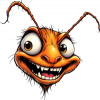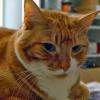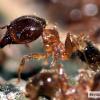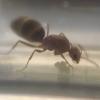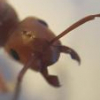- Formiculture.com
- Forums
- Gallery
- Members
- Member Map
- Chat

Carebara Diversa - 3 types of majors?
Started By
CoolColJ
, Apr 3 2018 3:28 PM
31 replies to this topic
#1
 Offline
-
Posted April 3 2018 - 3:28 PM
Offline
-
Posted April 3 2018 - 3:28 PM
Crazy - I didn't realise the could have so many different sizes of majors
Are they related to Pheidole at all?
Are they related to Pheidole at all?
- antsinvirgina likes this
Current ant colonies -
1) Opisthopsis Rufithorax (strobe ant), Melophorus sp2. black and orange, Pheidole species, Pheidole antipodum
Journal = http://www.formicult...ra-iridomyrmex/
Heterotermes cf brevicatena termite pet/feeder journal = http://www.formicult...feeder-journal/
#2
 Offline
-
Posted April 6 2018 - 3:50 PM
Offline
-
Posted April 6 2018 - 3:50 PM
Apparently we get Carebara affinis in Australia... smaller, but quite similar.
Hard to separate them from Pheidole from a quick glance, apart from size
Hard to separate them from Pheidole from a quick glance, apart from size
- antsinvirgina likes this
Current ant colonies -
1) Opisthopsis Rufithorax (strobe ant), Melophorus sp2. black and orange, Pheidole species, Pheidole antipodum
Journal = http://www.formicult...ra-iridomyrmex/
Heterotermes cf brevicatena termite pet/feeder journal = http://www.formicult...feeder-journal/
#3
 Offline
-
Posted April 6 2018 - 5:10 PM
Offline
-
Posted April 6 2018 - 5:10 PM
Apparently Antwiki lists them as having a minor caste, a major caste, and a soldier caste. No idea how that is determined but other species in the genus Carebara specifically the ones formerly known as Oligonomyrmx are normally dimorphic (Possible link here? idk I'm not a taxonomist). The entire genus of Carebara in general is known to have huge size differences between certain castes (usually queen and worker). There also seems to be a lot of unidentified species of what would be considered to be part of the old Pheidologeton genus, and indeed antwiki notes that literature usually feature C. diversa as a species complex.
They aren't related to Pheidole other then being in the same subfamily. Carebara is in the Crematogastrini tribe while Pheidole is in the Attini tribe.
- VoidElecent likes this
#4
 Offline
-
Posted April 6 2018 - 5:24 PM
Offline
-
Posted April 6 2018 - 5:24 PM
This picture posted a keeper of Carebara diversa (when it was still Pheidologeton diversus) 8 years ago in a German ant keeping forum: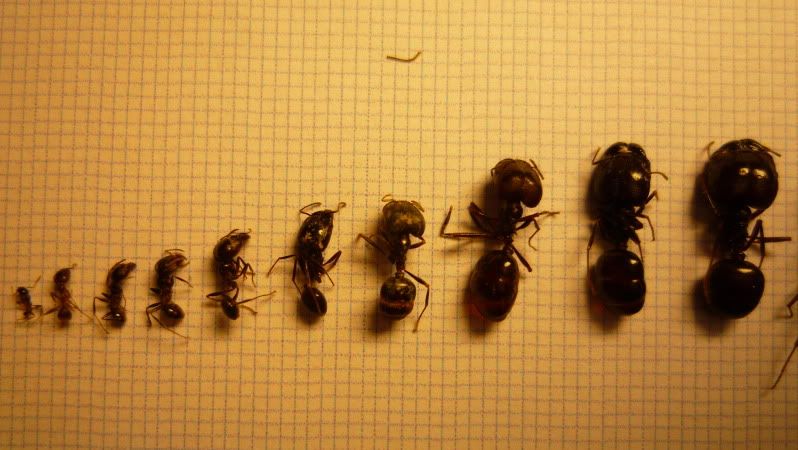
I think you can't really tell when the different sub-castes start and when they end they have fluid transitions from 3 mm to 18 mm.
One thing Pheidole don't but Carebara do is riding on larger ants like you can see in the video.
EDIT: Added Link to the post since it was in English ^^
Edited by Barristan, April 6 2018 - 5:55 PM.
- LC3, Martialis, VoidElecent and 3 others like this
#5
 Offline
-
Posted April 8 2018 - 8:53 PM
Offline
-
Posted April 8 2018 - 8:53 PM
Thanks, that's very interesting!
I wonder if the smaller Carebara affinis we have in Australia has the same continuously variable worker/major size.
They must be rare as I have not see a single queen/colony offered for sale by any one here, or reports of any being captured
Then again most people will just ID them as Pheidole...
The queen look so much like Pheidole queens as well, just larger
And they are also polygynous
One of the largest Pheidole species we have here look not unlike a Carebara queen, 10mm
And they do develop super majors


Edited by CoolColJ, April 8 2018 - 9:07 PM.
- VoidElecent likes this
Current ant colonies -
1) Opisthopsis Rufithorax (strobe ant), Melophorus sp2. black and orange, Pheidole species, Pheidole antipodum
Journal = http://www.formicult...ra-iridomyrmex/
Heterotermes cf brevicatena termite pet/feeder journal = http://www.formicult...feeder-journal/
#6
 Offline
-
Posted April 9 2018 - 5:35 AM
Offline
-
Posted April 9 2018 - 5:35 AM
This picture posted a keeper of Carebara diversa (when it was still Pheidologeton diversus) 8 years ago in a German ant keeping forum:
I think you can't really tell when the different sub-castes start and when they end they have fluid transitions from 3 mm to 18 mm.
One thing Pheidole don't but Carebara do is riding on larger ants like you can see in the video.
EDIT: Added Link to the post since it was in English ^^
damn that's an amazing
#7
 Offline
-
Posted April 9 2018 - 9:08 AM
Offline
-
Posted April 9 2018 - 9:08 AM
Crazy - I didn't realise the could have so many different sizes of majors
Are they related to Pheidole at all?
Carebara diversa is polymorphic, so you get all size ranges of workers.
The genus is not even in the same tribe as Pheidole (Crematogastrini vs Attini):
http://www.antwiki.o..._et_al_2015.pdf
Edited by kalimant, April 9 2018 - 9:10 AM.
I currently maintain a site dedicated to the hyper-diverse myrmicine genus Pheidole.:
I also own the Lurker's Guide to Leafcutters Ants
#8
 Offline
-
Posted May 2 2018 - 11:03 AM
Offline
-
Posted May 2 2018 - 11:03 AM
Looks like someone found one of the Australian Carebara species
video
click for larger



Edited by CoolColJ, May 2 2018 - 8:21 PM.
- Barristan and TennesseeAnts like this
Current ant colonies -
1) Opisthopsis Rufithorax (strobe ant), Melophorus sp2. black and orange, Pheidole species, Pheidole antipodum
Journal = http://www.formicult...ra-iridomyrmex/
Heterotermes cf brevicatena termite pet/feeder journal = http://www.formicult...feeder-journal/
#9
 Offline
-
Posted May 2 2018 - 2:14 PM
Offline
-
Posted May 2 2018 - 2:14 PM
Could be the early stages of a Carebarra affinis - black queen, red workers and majors.
The colony above is only 1 year old, and the queen did not produce any eggs until a few months after capture
Edited by CoolColJ, May 2 2018 - 4:50 PM.
- TennesseeAnts likes this
Current ant colonies -
1) Opisthopsis Rufithorax (strobe ant), Melophorus sp2. black and orange, Pheidole species, Pheidole antipodum
Journal = http://www.formicult...ra-iridomyrmex/
Heterotermes cf brevicatena termite pet/feeder journal = http://www.formicult...feeder-journal/
#10
 Offline
-
Posted May 2 2018 - 2:20 PM
Offline
-
Posted May 2 2018 - 2:20 PM
Looks like someone found one of the Australian Carebara species
video
https://video-syd2-1...851&oe=5AEA396D
click for larger
You sure this isn’t Pheidole antipodum?
#11
 Offline
-
Posted May 2 2018 - 2:25 PM
Offline
-
Posted May 2 2018 - 2:25 PM
You sure this isn’t Pheidole antipodum?
There are multiple sizes of majors, so that makes it less likely to be Pheidole.
yes there are some species of Pheidole that can have super majors, but they have a different appearance
Edited by CoolColJ, May 2 2018 - 2:34 PM.
Current ant colonies -
1) Opisthopsis Rufithorax (strobe ant), Melophorus sp2. black and orange, Pheidole species, Pheidole antipodum
Journal = http://www.formicult...ra-iridomyrmex/
Heterotermes cf brevicatena termite pet/feeder journal = http://www.formicult...feeder-journal/
#12
 Offline
-
Posted May 2 2018 - 2:32 PM
Offline
-
Posted May 2 2018 - 2:32 PM
P.antipodum is rather interesting among Pheidole, they’re a lot like former Pheidologeton Carebara in certain regards; large queens to workers, highly polymorphic, (most likely) subterranean.
http://www.antwiki.o...idole_antipodum
http://www.antwiki.o...idole_antipodum
- CoolColJ likes this
#13
 Offline
-
Posted May 2 2018 - 2:36 PM
Offline
-
Posted May 2 2018 - 2:36 PM
P.antipodum is rather interesting among Pheidole, they’re a lot like former Pheidologeton Carebara in certain regards; large queens to workers, highly polymorphic, (most likely) subterranean.
http://www.antwiki.o...idole_antipodum
The black queen and red workers does seem to match the profile
Current ant colonies -
1) Opisthopsis Rufithorax (strobe ant), Melophorus sp2. black and orange, Pheidole species, Pheidole antipodum
Journal = http://www.formicult...ra-iridomyrmex/
Heterotermes cf brevicatena termite pet/feeder journal = http://www.formicult...feeder-journal/
#14
 Offline
-
Posted May 2 2018 - 2:46 PM
Offline
-
Posted May 2 2018 - 2:46 PM
From Antwiki link -
This queen was found in Perth
Heterick (2009) - In the SWBP, WA these ants can be locally common in both laterite and sandy soils in the Perth region, where they are often found in association with termites. Nests are very frequently located under rocks. They also occur in the wheatbelt and along the south coast. Elsewhere in Australia, this ant has been recorded from NSW, the NT, SA and Vic.
Wheeler (1934) - A few specimens of this extraordinary ant were taken by Dr. Darlington from a small colony at Nancy Cove (X. 24, '31). It is rather rare in the vicinity of Perth but I found many fine colonies at Margaret River. Unlike nearly all the other species of the huge, cosmopolitan genus Pheidole, it is decidedly hypogacic in habits, has very poorly developed eyes and an extremely polymorphic soldier caste. The colonies must be very difficult to detect during the dry season. In the moist open forests about Margaret River, however, they are easily found under large stones deeply imbedded in the soil. When fully developed the colonies comprise hundreds of individuals and thousands of subspherical larvaei, and it is only in such flourishing colonies that one encounters perfect series of soldiers showing all the transitions between huge, large-headed forms and minute, small-headed workers proper. The appearance and behaviour of this ant is so different from other species of Pheidole that I am inclined to regard Anisopheidole as an independent, exclusively Australian genus.
Current ant colonies -
1) Opisthopsis Rufithorax (strobe ant), Melophorus sp2. black and orange, Pheidole species, Pheidole antipodum
Journal = http://www.formicult...ra-iridomyrmex/
Heterotermes cf brevicatena termite pet/feeder journal = http://www.formicult...feeder-journal/
#15
 Offline
-
Posted May 3 2018 - 2:11 AM
Offline
-
Posted May 3 2018 - 2:11 AM
The owner of that colony says the queen is over 1.5cm big so it most likely is a Carebara.
She cannot turn in a 16mm test tube.
P.antipodum queens are around 13mm
Current ant colonies -
1) Opisthopsis Rufithorax (strobe ant), Melophorus sp2. black and orange, Pheidole species, Pheidole antipodum
Journal = http://www.formicult...ra-iridomyrmex/
Heterotermes cf brevicatena termite pet/feeder journal = http://www.formicult...feeder-journal/
#16
 Offline
-
Posted May 6 2018 - 12:36 AM
Offline
-
Posted May 6 2018 - 12:36 AM
C.vespillo.
Ahh if only I was in asia, peeps are selling these
Queen:13-14mm
Minor 1.3-1.8mm
Medial/majors 3.5-7.8mm

https://img.alicdn.com/imgextra/i4/24298958/TB2hHgscFXXXXcJXXXXXXXXXXXX_!!24298958.jpg
https://img.alicdn.com/imgextra/i3/24298958/TB2wwsMcFXXXXX_XXXXXXXXXXXX_!!24298958.jpg
Ahh if only I was in asia, peeps are selling these
Queen:13-14mm
Minor 1.3-1.8mm
Medial/majors 3.5-7.8mm

https://img.alicdn.com/imgextra/i4/24298958/TB2hHgscFXXXXcJXXXXXXXXXXXX_!!24298958.jpg
https://img.alicdn.com/imgextra/i3/24298958/TB2wwsMcFXXXXX_XXXXXXXXXXXX_!!24298958.jpg
Edited by CoolColJ, May 6 2018 - 12:40 AM.
Current ant colonies -
1) Opisthopsis Rufithorax (strobe ant), Melophorus sp2. black and orange, Pheidole species, Pheidole antipodum
Journal = http://www.formicult...ra-iridomyrmex/
Heterotermes cf brevicatena termite pet/feeder journal = http://www.formicult...feeder-journal/
#17
 Offline
-
Posted May 6 2018 - 12:43 AM
Offline
-
Posted May 6 2018 - 12:43 AM
C. Affinis
Queen:18-20MM
Minor:2.0-2.5MM
Major :4.0-15MM
https://img.alicdn.com/imgextra/i1/24298958/T2mliaXlRXXXXXXXXX_!!24298958.jpg
https://img.alicdn.com/imgextra/i4/24298958/T2g8eaXnBXXXXXXXXX_!!24298958.jpg
https://img.alicdn.com/imgextra/i3/24298958/T2c8CaXelXXXXXXXXX_!!24298958.jpg
Queen:18-20MM
Minor:2.0-2.5MM
Major :4.0-15MM
https://img.alicdn.com/imgextra/i1/24298958/T2mliaXlRXXXXXXXXX_!!24298958.jpg
https://img.alicdn.com/imgextra/i4/24298958/T2g8eaXnBXXXXXXXXX_!!24298958.jpg
https://img.alicdn.com/imgextra/i3/24298958/T2c8CaXelXXXXXXXXX_!!24298958.jpg
Current ant colonies -
1) Opisthopsis Rufithorax (strobe ant), Melophorus sp2. black and orange, Pheidole species, Pheidole antipodum
Journal = http://www.formicult...ra-iridomyrmex/
Heterotermes cf brevicatena termite pet/feeder journal = http://www.formicult...feeder-journal/
#18
 Offline
-
Posted May 6 2018 - 12:47 AM
Offline
-
Posted May 6 2018 - 12:47 AM
C.latinodus
Queen:14-15mm
Minor:1.8-2.3mm
Major:3.8-12mm
https://img.alicdn.com/imgextra/i4/24298958/T2_xOaXc8bXXXXXXXX_!!24298958.jpg
https://img.alicdn.com/imgextra/i3/24298958/T2pi5aXb0XXXXXXXXX_!!24298958.jpg
https://img.alicdn.com/imgextra/i3/24298958/T2QyWaXehXXXXXXXXX_!!24298958.jpg
https://img.alicdn.com/imgextra/i1/24298958/T2z5SaXgtXXXXXXXXX_!!24298958.jpg
https://img.alicdn.com/imgextra/i3/24298958/T2yiWaXepXXXXXXXXX_!!24298958.jpg
Queen:14-15mm
Minor:1.8-2.3mm
Major:3.8-12mm
https://img.alicdn.com/imgextra/i4/24298958/T2_xOaXc8bXXXXXXXX_!!24298958.jpg
https://img.alicdn.com/imgextra/i3/24298958/T2pi5aXb0XXXXXXXXX_!!24298958.jpg
https://img.alicdn.com/imgextra/i3/24298958/T2QyWaXehXXXXXXXXX_!!24298958.jpg
https://img.alicdn.com/imgextra/i1/24298958/T2z5SaXgtXXXXXXXXX_!!24298958.jpg
https://img.alicdn.com/imgextra/i3/24298958/T2yiWaXepXXXXXXXXX_!!24298958.jpg
Current ant colonies -
1) Opisthopsis Rufithorax (strobe ant), Melophorus sp2. black and orange, Pheidole species, Pheidole antipodum
Journal = http://www.formicult...ra-iridomyrmex/
Heterotermes cf brevicatena termite pet/feeder journal = http://www.formicult...feeder-journal/
#19
 Offline
-
Posted May 8 2018 - 6:01 PM
Offline
-
Posted May 8 2018 - 6:01 PM

Sorry to go so far off topic here, but what is with the test tube? Why would anyone set one up with so little water?
Edited by Shifty189, May 8 2018 - 6:06 PM.
#20
 Offline
-
Posted May 8 2018 - 6:29 PM
Offline
-
Posted May 8 2018 - 6:29 PM
1 user(s) are reading this topic
0 members, 1 guests, 0 anonymous users





